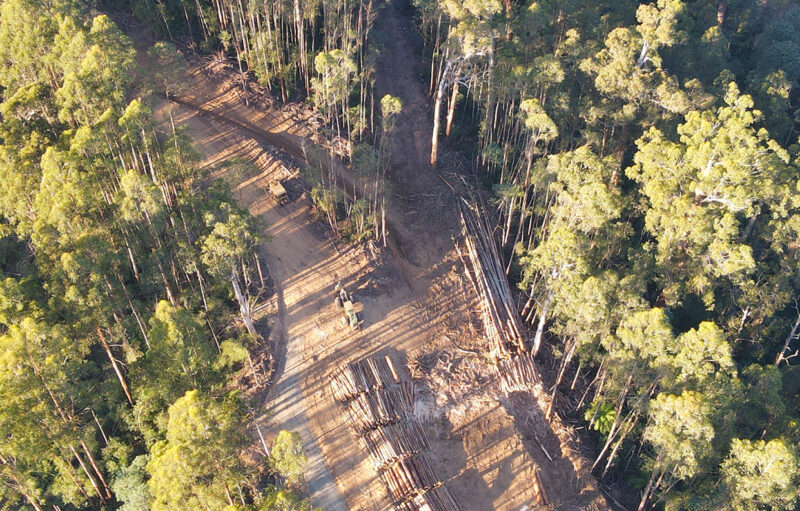PARK WATCH Article June 2024 |
Blake Nisbet, Nature Conservation Campaigner, on how Forest Fire Management Victoria is exacerbating a housing crisis for endangered wildlife
Back in 1995, Victoria had the foresight to protect Melbourne’s forested water catchments from logging via the establishment of the Yarra Ranges National Park. Now, in 2024 – following the State Government’s alleged ban on native forest logging – the logging machines have returned to the park. This time, they’ve shapeshifted into fire management.
Numerous hollow-bearing trees have recently been removed as part of ‘fire management’ operations. Many more are planned for removal within habitat critical for the survival of iconic threatened wildlife like the Critically Endangered Leadbeater’s Possum and Endangered Greater Glider.
Why is our national park being logged, you might ask? Well, these operations are being coined as the ‘maintenance’ and ‘renewal’ of existing strategic fuel breaks (SFBs). The kicker? Forest Fire Management Victoria (FFMV) has contracted VicForests to do the on-ground works.
For the more than 15 years that SFBs have been in place, maintenance has involved mowing regimes to suppress any regrowth. Now it involves the widespread logging of standing trees, including (allegedly hazardous) old-growth trees. This season alone 80km of SFBs are planned for logging. It’s not just trees within the breaks being targeted for removal: FFMV approves logging up to one tree length from the breaks! That’s about 800 hectares of the national park and neighbouring forests subject to rogue logging this season alone.
Homes not hazards
Citizen science group Wildlife of the Central Highlands (WOTCH) thoroughly surveyed the latest break targeted for logging – the Forty Mile Break north of Noojee. They documented trees FFMV identified as hazardous and marked for removal, indicated by a pink spray painted symbol on the base of the tree. WOTCH recorded at least 480 trees, including over 100 hollow-bearing trees. This includes trees citizen science surveyors identified as active denning/nesting trees for endangered Greater Gliders. Endangered animals are living inside these trees marked for removal.
VNPA and Friends of the Leadbeater’s Possum have commissioned tree assessments from an independent arborist (Melbourne Treecare) of a sample of the trees identified by FFMV. The arborist assessed 16 trees at the site, including some hollow-bearing trees.
The results cast serious doubt on the current policy and processes used by FFMV to assess for hazardous trees. All 16 trees were found to have a risk of ‘one in a million’ for harming humans – a broadly acceptable level of risk – with attributes that warrant a high retention value. The arborist found that none of the 16 trees need to be felled or removed, and recommended pruning works for six of them.
We observed that some trees initially earmarked for removal had their pink symbol scratched-off, undermining the integrity of FFMV’s hazardous tree assessments.
A litany of loopholes
This loophole logging is merely the latest onslaught on Victoria’s protected land network, conducted with zero transparency, regulation or oversight. It’s entirely inconsistent with a myriad of state and federal nature laws and policies. The Leadbeater’s Possum Recovery Plan, for example, was signed off by both the state and federal governments in March this year. It promised to protect all large and hollow-bearing trees, and prevent any modification or destruction of current and prospective Leadbeater’s Possum habitat. Still, logging machinery was seen destroying habitat just weeks after the plan’s release.
To date, FFMV has not referred these logging operations to the Federal Government for an assessment of significant impacts under the Environment Protection & Biodiversity Conservation 1999 (EPBC Act). Recent court proceedings from Save Our Strathbogies Forests prove that fire management operations are not exempt from federal nature laws.
We are calling for an immediate halt of these works until an assessment for significant impacts takes place. It’s incumbent on our state government to actively reverse any extinction trajectories of animals that call these forests home, animals like Leadbeater’s Possums, Greater and Yellow-bellied Gliders, the Smoky Mouse and Tooarrana (Broad-toothed Rat). The government must establish independent regulation and oversight of FFMV operations. Marking your own homework didn’t fly in school and it certainly doesn’t fly in our precious native forests.
Update
On 15 May, citizen scientists have found a dead Greater Glider near a felled habitat tree. The tragedy? We’d repeatedly warned state and federal ministers that gliders are living in the trees.
FFMV must put down their chainsaws and stop cutting down hollow-beating trees in the Yarra Ranges National Park. These works must cease until a proper ecological assessment is done.
Many of these old-growth trees have observations of Greater Gliders living in them. Some have Critically Endangered Leadbeater’s Possums recorded nearby.
On 24 May, Forest Fire Management Victoria felled yet another ancient hollowed tree in the Yarra Ranges National Park.
- Read the latest full edition of Park Watch magazine
- Subscribe to keep up-to-date about this and other nature issues in Victoria
- Become a member to receive Park Watch magazine in print
